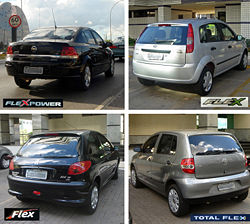- Multifuel
-
 Multifuel automobiles, from several manufacturers, popularly known as "flex" autos, that run on any blend of ethanol and gasoline.
Multifuel automobiles, from several manufacturers, popularly known as "flex" autos, that run on any blend of ethanol and gasoline.
Multifuel, sometimes spelled multi-fuel, is a term applied to any type of engine, boiler, or heater or other fuel-burning device which is designed to burn multiple types of fuels in its operation. One common application of multifuel technology is in military settings, where the normally-used diesel or gas turbine fuel might not be available during combat operations for vehicles or heating units. However, the growing need to establish fuel sources other than petroleum for transportation, heating, and other uses has led to increased development of multifuel technology for non-military use as well.
Contents
Mechanics
A multifuel engine is constructed so that its compression ratio permits firing the highest octane fuel of the various accepted alternative fuels. A strengthening of the engine is necessary in order to meet these higher demands.[1] Multifuel engines sometimes have switch settings that are set manually to take different octanes, or types, of fuel.[2]
Military multifuel engines
One common use of this technology is in the drive of military vehicles, so that they may run a wide range of alternative fuels such as gasoline or aviation (gas turbine) fuel. This is seen as desirable in a military setting as enemy action or unit isolation may limit the available fuel supply, and conversely enemy fuel sources, or civilian sources, may become available for usage.[3]
Currently a wide range of Russian military vehicles employ multifuel engines, such as the T-72 tank (multifuel diesel) and the T-80 (multifuel gas turbine).
Non-military usages
Many other types of engines and other heat-generating machinery are designed to burn more than one type of fuel. For instance, some heaters and boilers designed for home use can burn wood, pellets, and other fuel sources. These offer fuel flexibility and security, but are more expensive than are standard single fuel engines.[4] Portable stoves are sometimes designed with multifuel functionality, in order to burn whatever fuel is found during an outing.[5]
The movement to establish alternatives to automobiles running solely on gasoline has greatly increased the number of automobiles available which use multifuel engines, such a vehicles generally being termed a bi-fuel vehicle or flexible-fuel vehicle.
Underperformance issues
Multifuel engines are not necessarily underpowered, but in practice some engines have had issues with power due to design compromises necessary to burn multiple types of fuel in the same engine. Perhaps the most notorious example from a military perspective is the L60 engine used by the British Chieftain Main Battle Tank, which resulted in a very sluggish performance -- in fact, the Mark I Chieftain (used only for training and similar activities) was so underpowered that some were incapable of mounting a tank transporter. An equally serious issue was that changing from one fuel to another often required hours of preparation.[6]
Footnotes
- ^ Taylor, CF., The Internal-combustion Engine in Theory and Practice. p. 166.
- ^ Dunstan, S., Chieftain Main Battle Tank. p. 8
- ^ Dunstan, S., Chieftain. p. 8
- ^ See, for example, Pahl, G., Natural Home Heating: The Complete Guide to Renewable Energy, p. 145, 203.
- ^ See, for example, Jacobson, C., Expedition Canoeing: A Guide To Canoeing Wild Rivers In North America, p. 131.
- ^ Dunstan, Chieftain, p. 13
References
- Dunstan, Simon. Chieftain Main Battle Tank 1965-2003. Osprey Publishing, 2003. ISBN 1841767190
- Jacobson, Cliff. Expedition Canoeing: A Guide To Canoeing Wild Rivers In North America. Globe Pequot, 2005. ISBN 076273809X
- Pahl, Greg. Natural Home Heating: The Complete Guide to Renewable Energy. Chelsea Green Publishing, 2003. ISBN 1931498229
- Taylor, Charles Fayette. The Internal-combustion Engine in Theory and Practice. MIT Press, 1985. ISBN 0262700271
Categories:- Engines
- Fuels
- Energy development
Wikimedia Foundation. 2010.
